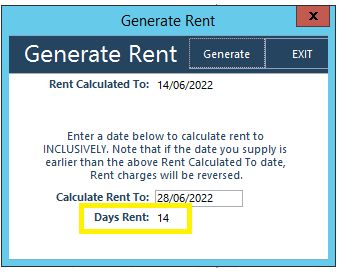After creating a new tenancy, you may want to generate the first 14 days rent for your tenancy. Usually, rent will be generated in bulk for all tenants, but there may be times when you will want to manually generate the rent individually for single tenancies.
This solution will cover:
- Generating the rent for 14 days for 1 Tenancy
- Generating less than 14 days of rent for one tenancy
- Reversing charges on an individual tenancy
- If you're unable to reverse the charges back
Generating the rent for 14 days for one Tenancy
To generate the rent for 14 days for one tenancy, click Tenancy in the toolbar and double click on the tenancy you want to generate the rent for.

The middle section of the screen shows the Tenancy Transactions Ledger. Usually for a new tenant, there will be one transaction of an Opening Balance (a credit for $0) and no other transactions.

Check the Rent Record is correct by clicking Edit Rent on the left hand side of the screen. Ensure the weekly amount of rent (and other charges) is entered and correct. Your Organisation may charge rent fortnightly, but the amount a Tenant will pay must always be entered as weekly in the Rent Record.
Ensure the Start Date of the rent record is the same date as the Tenancy Start Date on the left hand side of the screen.

The number of days that the rent will be generated for (either 7 days or 14 days) will default in the Generate Rent pop-up.
To generate 14 days of rent, click Generate.
A 14 day rent charge will now appear in the Tenancy Transactions ledger. It will show the Date you generated the rent, the Transaction Type as a Rent Charge, the Comments including the dates the rent was charged for, the Amount showing as a negative number (meaning a debit), and the Rent column will indicate it was a rent transaction. The Total balance will also show in debit.

If you are charging the Tenant other charges besides rent (EG furniture, garden charge, etc.), when you generate rent, the extra charges will be entered as a separate transaction(s).
The Rent Charged To date in the Tenancy record will now be updated to reflect the new rent charged to date:

NOTE: The Rent Charged To date should always match the last date in the most recent rent charge in the Tenancy Transactions ledger.
Generating less than 14 days of rent for one tenancy
To generate the rent for 14 days for one tenancy, click Tenancy in the toolbar and double click on the tenancy you want to generate the rent for.

Click Generate Rent. The Generate Rent pop up will open:

The number of days that the rent will be generated for (either 7 days or 14 days) will default in the Generate Rent pop-up.


Reversing charges on an individual tenancy
To reverse the rent back to a particular day, click Tenancy in the toolbar and double click on the tenancy you want to generate the rent for.

Click Generate Rent. The Generate Rent pop up will open:

The Rent Calculated To date will show the date 14 days in the future (this may show 7 days if your Organisation generates Rent on a weekly basis):

Delete the date in the Calculate Rent To field by highlighting and pressing <DELETE> on your keyboard, and enter the last date that the Tenant was charged rent for the room in the Calculate Rent To field.
When you click elsewhere on your screen, the number next to Days Rent become a minus number:

Click Generate.
Chintaro will recalculate the number of days charged for the period and the rent (and other weekly charges) will be reversed back to the last day the Tenant was charged rent for the room:
If you're unable to reverse the charges back
If you have tried to reverse the charges back but you're unable to, it is most likely due to the rent charges having been sent to the General Ledger. If this is the case, the transactions will be locked and you will need to add a Credit Rent Adjustment to credit the Tenancy for overcharging them (alternatively, speak to your Finance team about if they can delete the batch that was sent to the GL).
Was this article helpful?
That’s Great!
Thank you for your feedback
Sorry! We couldn't be helpful
Thank you for your feedback
Feedback sent
We appreciate your effort and will try to fix the article